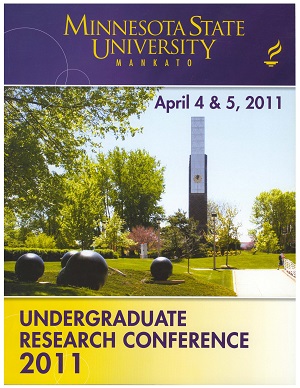Quantifying Sedimentary Iron Mineral Abundance with X-Ray Diffraction
Location
CSU 253/4/5
Start Date
4-4-2011 11:00 AM
End Date
4-4-2011 12:30 PM
Student's Major
Chemistry and Geology
Student's College
Science, Engineering and Technology
Mentor's Name
Chad Wittkop
Mentor's Department
Chemistry and Geology
Mentor's College
Science, Engineering and Technology
Description
The iron carbonate mineral siderite forms in a restricted geochemical environment and is often associated with hydrocarbons and iron ore deposits. Previous work has detected abundant siderite within the sediments of Otter Lake, Michigan.
Carbonate mineral abundances are commonly quantified using loss-on-ignition (LOI). However, siderite decomposes during LOI, and other methods must be used to determine its abundance. We used x-ray diffraction (XRD) to quantify siderite abundance in Otter Lake sediments. When x-rays encounter a row of atoms in a crystalline structure, the x-rays diffract at an angle that is characteristic of that mineral or element. We calibrated the x-ray diffractometer with a series of powdered siderite samples spiked with an external standard of corundum powder from percentages of 50-90% corundum by mass. We then determined the XRD intensity ratio of siderite and corundum peaks, analyzed the relationship between the percent of siderite to this intensity ratio, and fit this relationship to a quadratic equation. We then employed this equation to quantify siderite abundance in XRD scans of sediments from an Otter Lake sediment core spiked with corundum at 20cm intervals. Following XRD scans, we determined the organic carbon content of the sediments using LOI and performed stoichiometric corrections to account for the decomposition of siderite.
This project enhanced our understanding of this unusual occurrence of siderite by quantifying changes in its abundance in the sediments of Otter Lake, Michigan through time and correlating them with known Holocene climatic changes recorded in other lakes in the region.
Quantifying Sedimentary Iron Mineral Abundance with X-Ray Diffraction
CSU 253/4/5
The iron carbonate mineral siderite forms in a restricted geochemical environment and is often associated with hydrocarbons and iron ore deposits. Previous work has detected abundant siderite within the sediments of Otter Lake, Michigan.
Carbonate mineral abundances are commonly quantified using loss-on-ignition (LOI). However, siderite decomposes during LOI, and other methods must be used to determine its abundance. We used x-ray diffraction (XRD) to quantify siderite abundance in Otter Lake sediments. When x-rays encounter a row of atoms in a crystalline structure, the x-rays diffract at an angle that is characteristic of that mineral or element. We calibrated the x-ray diffractometer with a series of powdered siderite samples spiked with an external standard of corundum powder from percentages of 50-90% corundum by mass. We then determined the XRD intensity ratio of siderite and corundum peaks, analyzed the relationship between the percent of siderite to this intensity ratio, and fit this relationship to a quadratic equation. We then employed this equation to quantify siderite abundance in XRD scans of sediments from an Otter Lake sediment core spiked with corundum at 20cm intervals. Following XRD scans, we determined the organic carbon content of the sediments using LOI and performed stoichiometric corrections to account for the decomposition of siderite.
This project enhanced our understanding of this unusual occurrence of siderite by quantifying changes in its abundance in the sediments of Otter Lake, Michigan through time and correlating them with known Holocene climatic changes recorded in other lakes in the region.
Recommended Citation
Lubenow, Brady L.. "Quantifying Sedimentary Iron Mineral Abundance with X-Ray Diffraction." Undergraduate Research Symposium, Mankato, MN, April 4, 2011.
https://cornerstone.lib.mnsu.edu/urs/2011/poster-session-B/20



